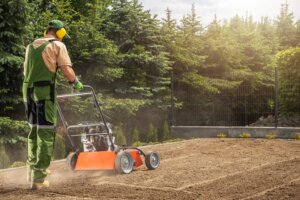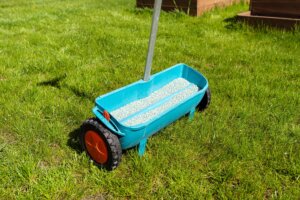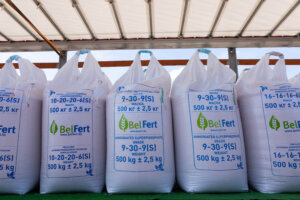Want a greener lawn that stands out in Pennsylvania? Knowing how to apply lawn fertilizer the right way makes all the difference. Whether you’re caring for a small yard or managing turf across the Tri-State area, these expert tips will help you grow thicker, healthier grass year-round.
Key Takeaways
- Start with a soil test to determine what nutrients your lawn actually needs.
- Choose the right fertilizer type for your grass and season: cool- vs. warm-season grasses have different needs.
- Use a fertilizer spreader for even coverage and avoid fertilizer burn.
- Water after fertilizing to help nutrients absorb into the soil.
- Maintain with regular mowing, aeration, and weed control to keep your lawn healthy year-round.
Why Proper Fertilization Matters for Healthy Turf
Fertilizing your lawn is like feeding your turf a balanced meal; it provides the essential nutrients that promote growth, color, and resilience. Learning how to apply lawn fertilizer correctly ensures your yard stays healthy through every season, especially in Pennsylvania’s varied climate.
Start with a Soil Test
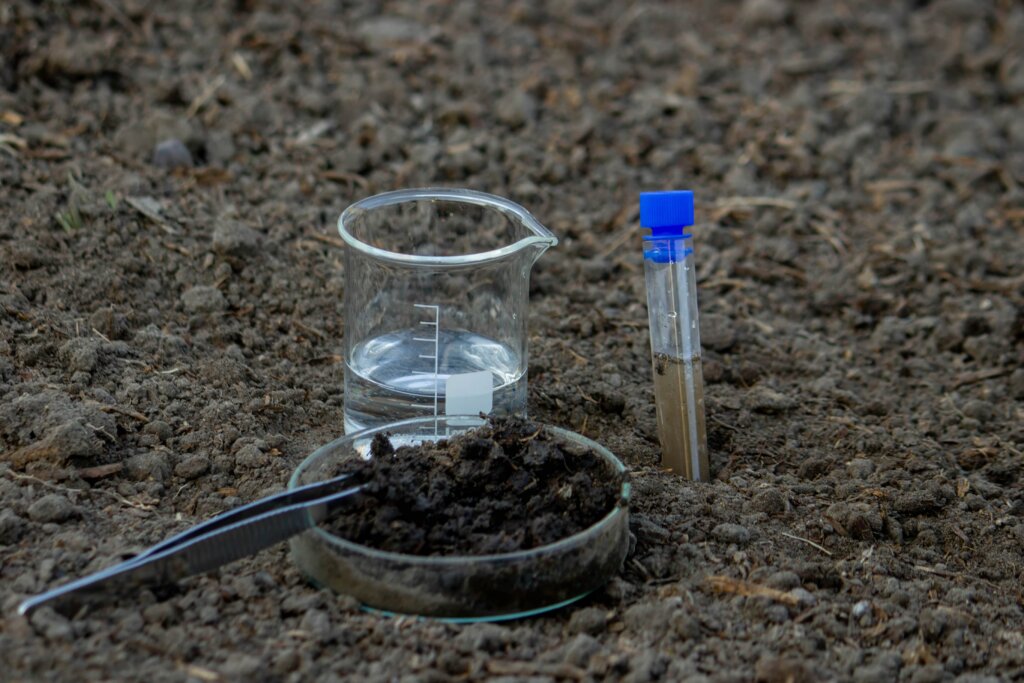
Before adding any fertilizer, test your soil to identify nutrient levels and pH balance. A professional soil test determines whether your yard needs more nitrogen or potassium to strengthen roots and improve turf health. You can also ask experts at Terra Lawn Care to analyze your soil and recommend a precise treatment plan for your entire lawn.
Choosing the Right Fertilizer
Understand Your Lawn’s Needs
Every lawn has unique nutrient requirements. Start with a soil test to determine your soil’s pH and nutrient levels. This helps you decide if your grass needs more nitrogen, phosphorus, or potassium, the three key ingredients in most fertilizers.
- Grass Type: Cool-season grasses like Kentucky bluegrass and perennial ryegrass need different nutrient ratios than warm-season grasses.
- Lawn Health: Established lawns may only need maintenance feedings, while newer or damaged lawns benefit from fertilizers with higher nitrogen content.
Granular Fertilizer vs. Liquid Fertilizer
Choosing between granular and liquid fertilizer depends on your lawn’s needs, size, and desired results. Here’s a quick comparison to guide your next fertilizer application:
| Granular Fertilizer | Liquid Fertilizer |
|---|---|
| Provides even, long-lasting coverage using a fertilizer spreader. Ideal for most lawns and established lawns. | Delivers a quick nutrient boost for stressed or thinning turf; best applied with a garden hose sprayer in small areas. |
| Releases nutrients slowly to promote steady growth and reduce fertilizer burn. | Absorbs quickly through the soil and grass roots, making it ideal for fast recovery during the growing season. |
Both options feed your entire lawn effectively: granular fertilizer for consistency and liquid fertilizer for quick results.
Organic vs. Synthetic Fertilizer
Your choice between organic and synthetic fertilizer affects both short-term results and long-term soil health. Compare them below:
| Organic Fertilizer | Synthetic Fertilizer |
|---|---|
| Builds soil structure and increases organic matter over time using natural materials. | Provides faster results with concentrated nutrients but needs careful use to prevent fertilizer burn. |
| Improves microbial activity and overall soil health for sustainable lawn care. | Offers precise nutrient control, suitable for cool-season grasses or lawns needing immediate recovery. |
Each fertilizer type supports a greener lawn; choose based on whether you prioritize quick visible growth or long-term soil health.
Slow vs. Quick-Release Fertilizers
Different fertilizer products serve specific lawn needs. Here’s a quick look at how slow-release and quick-release fertilizers compare:
| Slow-Release Fertilizer | Quick-Release Fertilizer |
|---|---|
| Feeds your lawn gradually for steady growth and fewer applications. Ideal for consistent nutrition and to fertilize your lawn over time. | Delivers immediate nutrients for fast green-up. Great for quick recovery but needs careful use to avoid overfeeding. |
Both fertilizer types can keep your lawn healthy; choose based on whether you prefer steady feeding or a rapid boost.
How Much Fertilizer to Use
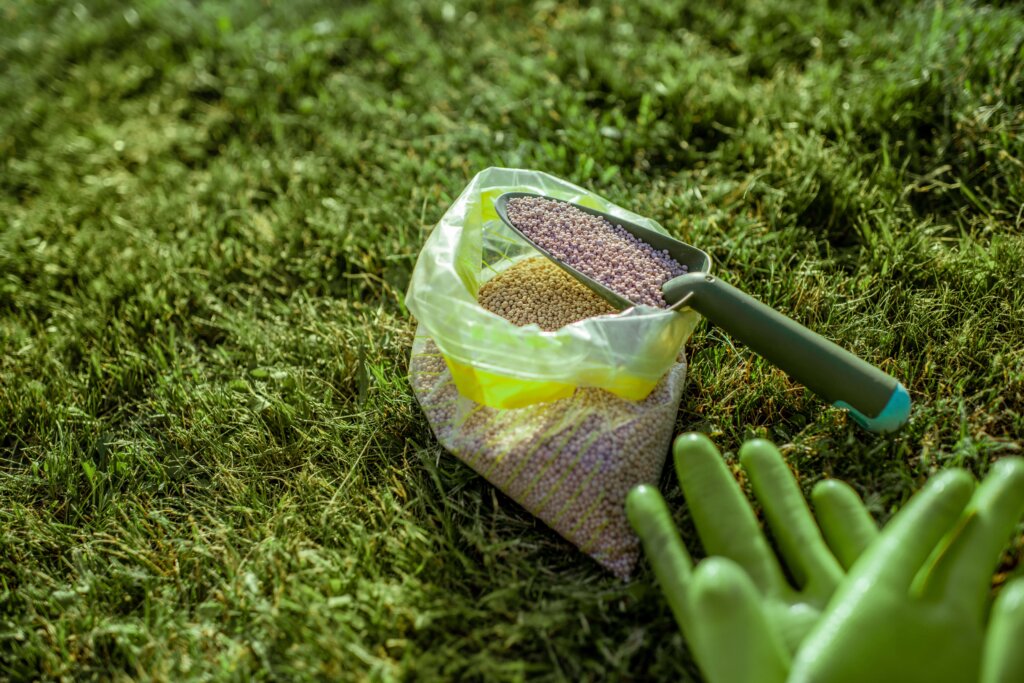
Determining how much fertilizer to apply depends on your lawn size and the product’s nutrient concentration.
- Measure your square footage by multiplying length × width.
- Follow the fertilizer’s packaging for recommended settings and application rate.
- Avoid over-application; too much nitrogen can cause fertilizer burn or runoff pollution.
When in doubt, apply less rather than more. Overfeeding your turfgrass won’t make it greener; it can do more harm than good.
The Best Time to Fertilize Your Lawn
When learning how to apply lawn fertilizer, timing is just as important as type. Use this guide to fertilize your Pennsylvania lawn at the right points during the growing season:
| Season | When to Apply Fertilizer | Purpose |
|---|---|---|
| Early Spring | Apply as the grass begins actively growing after winter. | Restores nutrients and repairs winter injury for a stronger start. |
| Late Spring to Early Summer | Feed when turfgrass growth peaks. | Strengthens roots and builds resilience against summer heat and stress. |
| Fall | Fertilize cool-season grasses before dormancy. | Helps cool-season grasses store energy for a greener comeback next spring. |
Each season supports a different growth phase: warm-season grasses thrive with summer feedings, while cool-season grasses prefer spring and fall fertilization for optimal health.
How to Apply Lawn Fertilizer
Step 1: Measure and Prepare
Determine your lawn size and fill the spreader according to the fertilizer’s instructions. Choose a calm day to prevent product drift on driveways or sidewalks.
Step 2: Use a Fertilizer Spreader
The University of Maryland recommends using a lawn spreader to apply fertilizer, never by hand. A broadcast or rotary spreader works best for larger yards, while drop spreaders are ideal for smaller or oddly shaped lawns.
Maintain a steady pace and apply in straight lines for even coverage. For precision, make two passes, one vertically and one horizontally, at half the recommended rate.
Step 3: Even Application
Apply the fertilizer evenly across the lawn, ensuring no area is missed or overlapped. Following the guidelines on the fertilizer bag for the proper setting to apply the correct amount of nitrogen to your lawn is essential.
Watering After Fertilization
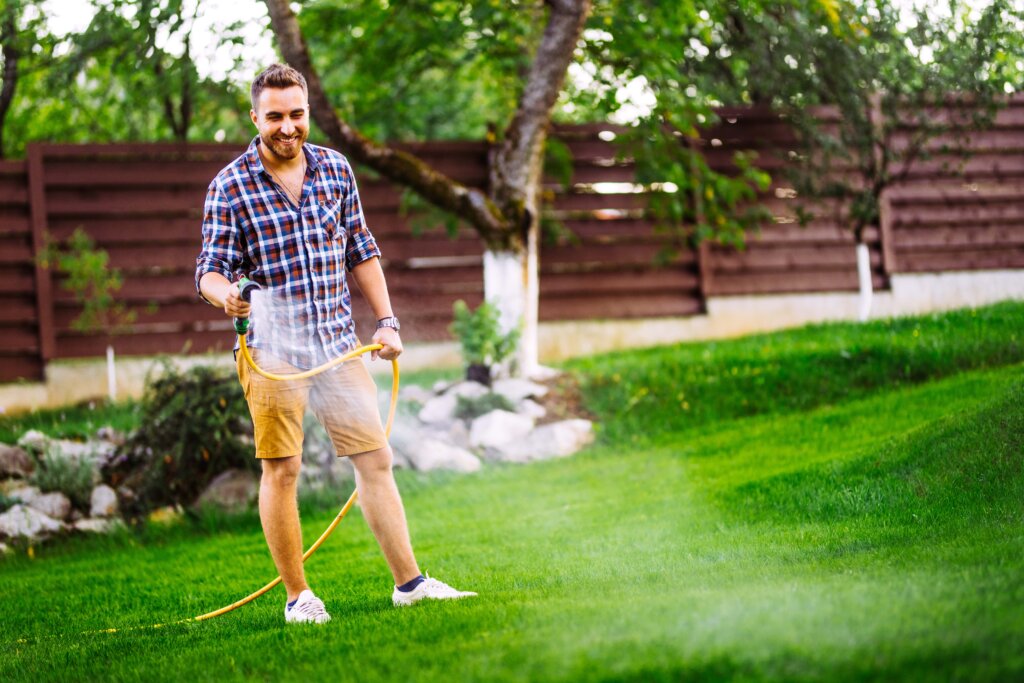
Watering your lawn after applying fertilizer is essential for nutrient absorption and root activation. Water thoroughly but not excessively to help nutrients penetrate the soil. Avoid overwatering, which can leach nutrients or cause runoff.
Common Mistakes to Avoid
- Skipping the Soil Test: Leads to guesswork and nutrient imbalance.
- Using Too Much Nitrogen: Causes rapid top growth but weak roots.
- Applying on Windy Days: Fertilizer can scatter onto non-turf areas.
- Overwatering: Can wash away nutrients before the grass absorbs them.
- Ignoring Grass Clippings: Leaving clippings on your lawn adds organic matter and returns natural nutrients to the soil.
Maintaining Healthy, Established Lawns
Once you’ve mastered how to apply lawn fertilizer, proper maintenance keeps results long-lasting:
- Mow regularly and leave grass clippings to recycle nutrients.
- Control broadleaf weeds with selective herbicides when needed.
- Aerate annually to improve root growth and soil health.
For professional fertilization services across the Tri-State area, our state-certified technicians are here to help.
Your Local Lawn Care Partner
Since 2003, Terra Lawn Care has been helping Pennsylvania homeowners achieve greener lawns with science-backed care. Overseen by an in-house agronomist and a team with over 50 years of combined experience, Terra provides tailored fertilization programs designed for the local climate and soil conditions. For expert guidance or a free consultation, contact us today.
Frequently Asked Questions about How to Apply Lawn Fertilizer
To fertilize your lawn properly, use a spreader and move in straight lines to ensure even coverage. This prevents patchy growth and overapplication that can damage plants.
For applying granular fertilizer, fill the spreader according to the product instructions and make two passes: one horizontally and one vertically. Always store any leftover fertilizer in a dry place for future use.
Yes, you should water your lawn after you fertilize. Water helps the nutrients soak into the soil and reach the grass roots. Just avoid overwatering; too much can wash away the fertilizer. Light watering is best, especially after using quick-release fertilizer, since it activates faster and needs moisture to absorb properly.
It’s best to fertilize your lawn when the grass is dry, but the soil is slightly moist. This helps the fertilizer stick to the ground instead of washing off.
Avoid applying fertilizer right after rain or heavy watering. After applying granular fertilizer, lightly water the lawn to help nutrients break down without creating runoff.
The best time to fertilize your lawn depends on your grass type. Cool-season grasses (like Kentucky bluegrass) grow best with spring and fall applications, while warm-season grasses prefer summer feeding.
Each season supports different needs; using fertilizers with balanced micronutrients helps promote healthy growth year-round. Avoid fertilizing during extreme heat to prevent damage to your plants and soil.

